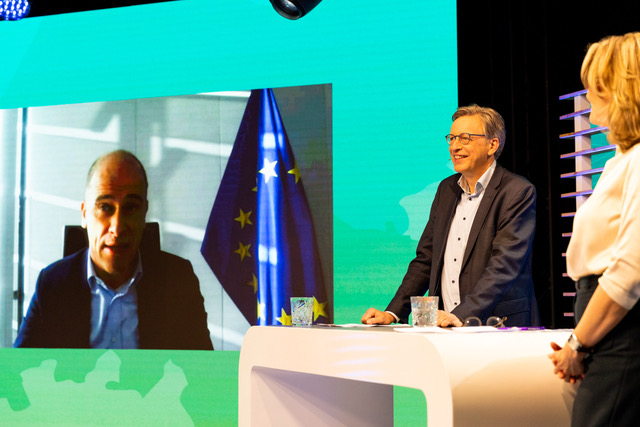
Within the Climate Accord, agreements have also been made regarding the process manufacturing industry on reducing CO2 emissions, as well as the raw materials transition. The opportunities and sticking points that these entails were discussed at the online summit held on February 24. On the occasion of the summit, a coalition of 17 parties signed a declaration of intent to start working on this greening transition and the ‘Groene chemie, nieuwe economie’ (Green Chemistry, New Economy) Action Agenda with 22 action points that was presented to Focco Vijselaar, Director-General for Business and Innovation at the Dutch Ministry of Economic Affairs and Climate (Economische Zaken en Klimaat, EZK for short).
The green chemistry transition was initiated by the Economic Network South Netherlands (ENZuid). This is on account of the high concentration of the large chemical clusters in Zeeland-Flanders, Moerdijk and Geleen respectively. However, the transition to green chemistry is not only a regional issue but one of national and even European importance. Moreover, reducing CO2 and using sustainable raw materials are no longer just a matter of the right technology, but are primarily an economic issue. Chain formation, the lack of adequate funding and regulation that lowers the threshold – which is necessary for the scaling up of already existing green initiatives – are all cited as the main obstacles. The action agenda with 22 concrete action points should help to crystallize all this.
CO2 reductions
Speakers from government, business and knowledge institutes were invited to the online summit on February 24 to exchange views on this topic, including Diederik Samsom (European Commission, Green Deal), Wouter Bos (Invest-NL), Frank Kuijpers (SABIC), Gustaaf Savenije (Top Sector HTSM, VDL), Willem Sederel (Circular Biobased Delta), Emmo Meijer (Top Sector Chemicals) and Paul de Krom (TNO). They all agreed: The green transition to 2030 and beyond is an enormous challenge. However, it is also clear that something needs to be done. And it has to happen now. The present-day petrochemical industry is home to some of the largest polluters. And although the main focus, for now, is on reducing CO2 emissions through the transition to green fuels, achieving the climate targets for the chemical manufacturing industry will lead to an annual reduction of 40 megatons of CO2.
Changing fundamental processes
Arnold Stokking, CEO of the knowledge center Brightsite and driving force behind ENZuid, the organizer of the event, said he was “really pleased” that all of the invited speakers actually attended the summit. Because this just goes to show how much the urgency of the problem is felt by all parties involved. Stokking spoke of a “momentum” leading the way. “The gas tap in Groningen must be closed, we must get rid of coal plants, cars must drive on electricity. It’s in this momentum that we need to talk. However, not about oil and gas as fuels, but rather as raw materials.”
According to Stokking, a lot is also happening already in the run-up to 2030: “The government and companies are working on the construction of infrastructure, hydrogen pipelines, electricity cables, green hydrogen, large CCS projects with CO2 storage under the North Sea and large wind farms using electrolysis. With these, we will also be able to meet the targets for 2030. But it is not enough for 2050. We need to start taking steps now in order to achieve the 2050 goals. That means introducing and scaling up new raw materials and new electrical processes now. We need the full 30 years up until 2050.”

Momentum
But 2030 – isn’t that very soon? Especially for an industry that is set up in such a way that it can hardly compete with the optimization of oil prices? Doesn’t that make you ‘rather nervous’?
Emmo Meijer, who attended the summit on behalf of the Top Sectors Chemicals, HTSM and Energy, is optimistic despite his concerns. The fact that he is speaking on behalf of no less than three top sectors at the summit also proves, in his opinion, that you can now speak of a cross-sectoral approach. “As far as I’m concerned, the nature of the task lies in that cooperation.”
Although he concedes that: ” It is an ambitious task. By 2050, all raw materials must be circular. And by 2030 we’ve got to be halfway there. The good news is that we are well on our way with the technology so far. It has also been shown that it is entirely plausible to meet these targets. In the meantime, however, we must get down to work. The Action Agenda specifies what is needed to achieve this. We are now investing in a great many areas, it will all come together in the end.”
Total transformation
The greening of the chemical sector calls for chain formation, emphasizes Anton van Beek, CEO of chemical group DOW Benelux. “We work intensively with SMEs and with other companies. Such as those in the steel industry, which enables us to use carbon dioxide as a raw material.” According to Van Beek, there is currently a huge focus on green chemistry, such as the production of green hydrogen, but also on making manufacturing chains circular. “Expectations are high. We want to show society that it can be done! And not just with demos but also with large-scale projects. We must not lose the lead that we have as the Netherlands. Otherwise, others will run off with it.”
Likewise, Frank Kuijpers, General Manager Corporate Sustainability at SABIC, underlines the importance of follow-up steps as well. “The investment decision for a demo plant has been made for a factory for the company “Plastic Energy.” It uses pyrolysis to convert plastic waste into raw material for circular polymers. And now it is a case of scaling up. We can go from the currently envisioned 20 kilotons to 200 kilotons and more within a few years. We want to head towards a total transformation!”
From demo installations to pilot factories
Although the necessary steps have already been taken in terms of financing, substantial investments are still needed. If only to be able to enter the price war with the traditional, fossil-based chemical industry. This industry has been optimized to such an extent over the years that it is virtually impossible to compete against it with sustainable innovations. Carbon pricing will have to continue in order to round out the business cases. At the same time, new solutions will have to be fostered. This in turn will enable upscaling, whereby the impact of increased volumes will have a positive influence on the business cases.
What can investors contribute now to move from demo installations to pilot factories? Wouter Bos, CEO of investment fund Invest-NL: “Our task is to use the annual EZK subsidy to form coalitions. But also to lower the threshold for funding aimed at a carbon-neutral, circular economy. The public sector task is enormous. And although Invest-NL is not a subsidizer, we would like to have a seat at the table with parties. And then we will take a look: What do these innovations need in order to receive funding?”
Green Deal and Recovery Plan
Things are also happening at a European level. Diederik Samsom, Chief Cabinet Secretary to the Vice-President of the European Commission Frans Timmermans, therefore welcomes the Action Agenda and the coalition. “This development fits in very well with the European Green Deal program. With that, we aim to pull all kinds of strings. I’m glad that this is now also happening here at the end of the string – namely industry. The CO2 transition demands enormous commitment. Not only from entrepreneurs but also from public actors such as the European Union.
Would you like to enter Europe in the near future with products that have a higher CO2 footprint? Then you are going to have to pay for that. ” Diederik Samsom
The EU will make the needed contributions, both in terms of money and regulations.
Samsom: “The Green Deal program will guide us in our ambition to be completely CO2-free and fully circular by 2050, but also to stop the loss of biodiversity. This encompasses all kinds of aspects, including energy, transport and nature. To do this, a comprehensive plan is needed, whereby sustainability and circularity go hand in hand. Add the corona epidemic to that.”
Yet these same challenges also present an opportunity. Given that within the Green Deal program, €5.6 billion has been made available in the form of a grant to the Netherlands specifically for climate-related investments. As part of the corona crisis European Recovery Plan.
Samsom: “So, make sure you get a place under this plan! This money can help take your business case further.”
Competitive position and CO2 tax
While this stimulus from Brussels is much appreciated, Stokking also wants to know about the competitive position of the Dutch process manufacturing industry: “How is Europe going to protect us from the rest of the world?”
”Samson: ” I can now reveal that this will also be their commitment in the years to come. We are going to be doing things differently over the coming period. We will adopt a more assertive attitude. Would you like to enter Europe with products that have a higher CO2 footprint? Then you are going to have to pay for that. That was taboo for a long time, especially in the Netherlands. But we see that in the intervening period, there is definitely support for a CO2 border tax.”
Making commercial green products
Although a coalition “with an impressive list of participants” has now been formed and will hopefully be joined by many more names in the future, it is now time to take action, take ownership and aim for results. Stokking: ” In doing so, we need to take a step towards the Netherlands, to ensure that the national parties embrace the plan. But also at a European level within the framework of the European Green Deal. We can use our knowledge and expertise to drive innovation. We have an excellent chemical industry in the Netherlands. Now companies, financiers and governments must take the next step together: As in, making commercial green products possible!”
Main picture: Diederik Samsom en Arnold Stokking (to the right).

